Thursday, 8 September 2011: Fromita
We are up early and head to nearby Solares to do some grocery shopping at Carrefour. This is a massive and I mean massive supermarket – you name it you can get it. Scott was in heaven in the jamon area of the store – huge, took him ages to make his mind up on what ham he wanted for his sandwiches. All stocked up, we head to Rubalcaba and use the Aires to empty the toilet cassette and fill up on some water before finding a spot to wait for the riders to come through and grab some feed bags etc. We find a good spot on an incline just before the sprint and low and behold the tour cars decide we are in a good spot and come and put their cars right where Scott has his flag out. We then move up a bit more and other cars come.
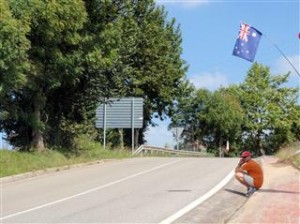
Eventually the riders come through and it is a huge panic to get all the dropped items. Scott scores two feed bags (Geox and Omega Lotto), so he is happy and we trundle back into town and just as we are leaving town we run into Ben and Clare who are heading down south. We make a quick drive to Noja to watch the finish of the day’s racing. Noja looks like an awesome town, but we too are heading south, so decide to put in some kilometres tonight while the sun is shining.
We eventually pull into an Aries in Fromista as it is getting dark. Scott talks to the motorhome couple next to us who are from Ireland. It is so expensive there and unemployment so bad they have sold up everything, bought a motorhome and are moving to Portugal to find somewhere to live, totally awesome. They have only been driving the motorhome a day, so everything about the trip is totally new to them.
Friday, 9 September 2011: Toledo (via Segovia)
Up early and off to Segovia. This is a Unesco World Heritage listed area and it certainly is beautiful. The drive is very arid with little to see except wind turbines and solar panels. Segovia appears on the horizon. It was originally founded in 80BC and was an important roman settlement. We easily find a parking spot, have a bite to eat and walk up into town. The first thing you see is the giant roman aqueduct. This is huge and rises to approximately 28m high. Made up of huge granite boulders (no cement for these lads) and brings water from the mountains to the town.
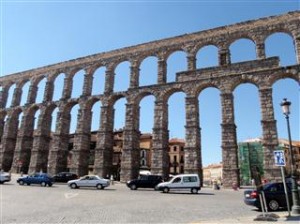
After the Aqueduct is a visit to the Catedral. This is built in the gothic style of architecture and seems to be typical of what we have seen in Spain so far. Everything inside is grim, no cheering or happy paintings. However, the amount of gold and other artefacts again highlights how rich the Catholic church is to the detriment to all those around it. The cathedral was started in 1525 but had many people working on it over the decades.
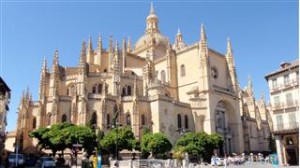
We walked up to the Alcazar but didn’t go in as it is now some sort of archive museum. However you do get good views of the surrounding town and it is a nice walk along the walls of the city. Segovia is a great place – lots to see, do and eat, but we are off further afield, so after our fill of sightseeing, we head off on the road to Toledo. It is a very hot drive and there aren’t many petrol stations either, so we had to back track to find one as we are getting a bit low and the last thing we want to do out in the middle of nowhere is to try and find an RAC truck.
We were planning to stop at a camping spot along the way, but it didn’t look very appealing, so continued onto Toledo where there is a campsite (el Greco). We followed the random directions on the GPS, but alas there are some major roadworks in progress, so we felt like we were going in circles. We pulled into Toledo and headed to the campsite to find a large car park, hmm not boding well. We decide to drive on up the road a bit more and finally found El Greco. This is an awesome campsite (although pricey), but has nice shaded spots, great laundry and washing facilities (spotlessly clean), a restaurant (with misters for the hot afternoon) and also a swimming pool which luck would have it closed for the end of the season yesterday.
We decamp and decide to have a drink and then dinner in the restaurant while the washing machine is attempting to destink our clothes (and what a fantastic washing machine/dryer it was). The wine was nice and cold, although the service was nonexistent. We ordered dinner to find that my meal was enough to feed about 4 people and the salad was enough for the both of us, however, we gave it the best we could finally staggering back to the camper tired but full. The views from the restaurant are fantastic and you can see the city lit up.
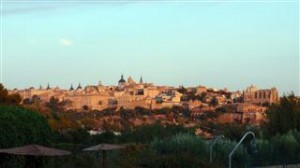
Saturday, 10 September 2011: Toledo
There is a bus from the campsite into Toledo so we head out at 10:10. The bus ride is about 10 minutes but at least takes us to the top of the town. We stand in the mammoth long queue at the tourist office for a map and then head off into the maze of streets and tourist sites. This is a great place which we didn’t realise. It was originally a roman city, but was also resided in by the Catholics, Jews and Muslims for many centuries until the Catholics made the Jews and Muslims convert, massacred them or exiled them – go the catholic church. However, luckily there are some relics of their religions left. Strangely enough the synagogue now appears to be run by the catholic church (there is even a nun selling souvenirs) with a note saying that all religions should live in harmony blah blah blah, wonder if they realise how hypocritical that saying is.
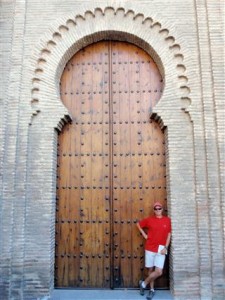
We walk around every which way and then find a little laneway and have a fantastic lunch (I had grilled vegetables and Scott had the mixed grill which had a bit of everything and was huge) all washed down with wine and beer and a chat to a couple of Americans where were driving through Spain, although that also included a detour to Bordeaux for wine tasting.
We walked back to the campsite, although it was now hot, but time for siesta the walk only took about 20 minutes. As we were sitting down to our motorhome cooked dinner, who should drive up but Ben and Clare after a few days doing their sightseeing, it was great to sit down with a glass and see what they have been up to which is as always interesting. They are going to stay in Toledo tomorrow, but we are heading off. Like us they too are struggling a little bit in Spain in trying to find that typical Spanish village.
Sunday, 11 September 2011: Granada
The drive from Toledo to Granada was boring, so boring. It was endless scenery of olive trees with some more olive trees to break things up a bit.
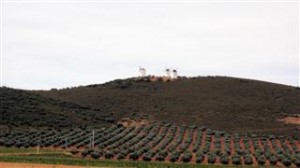
The drive felt like it lasted forever and we only had a short break for something to eat before getting back into the van. We arrived in Granada and headed straight to the Aries de camping to find that it seemed to be an underground carpark and therefore we couldn’t fit and there was a fun fair next door. So we drove instead onto Reina Isabel Camping (www.reinaisabelcamping.com) where we got a campsite, not fantastic, but really cheap as they are an ACSI campsite, plus they had a swimming pool that was open (unlike El Greco in Toledo) and was very inviting. The reception counter can also book your tickets for Alhambra, so we booked for tomorrow and then unpacked Vinnie and headed to the pool. The drive had been long, hot and dusty and Scott cracked open a beer and distressed floating in the pool. Meanwhile I tried to catch some rays and even out my tan.
Monday, 12 September 2011: Granada
We decide to get up early and head into Granada so that we leave ourselves plenty of time to get to Alhambra and not be rushed. We get the 9:30am bus (no. 175-177) from right outside the campsite (Reina Isabel Camping (www.reinaisabelcamping.com)) which whisks us into Granada where we change onto the No. 13 bus to Alhambra. The bus stops right out the front of the site and one of the nice gentlemen on there points us in the right direction. This journey took about an hour. We wander down through the entrance where the tour buses are already disgorging their clients. Our ticket into Alhambra is for 12:30 which leaves us about 2 hours to wander through Generalife, Alcazaba and the other gardens surrounding the Palacios Nazaries. We queue up for our tickets official as all you get off the website is a printout which must be exchanged for the tickets at the entrance gates and then queued up for an audioguide (big tip here – don’t bother). So we have the tickets with our times on it and off we go. Alhambra is described as the stuff of fairy tales, but to be honest first impressions are a tad disappointing. Alhambra was built in the 9th century as a fort before being converted into a fortress-palace in the 13-14th centuries. After the Christian conquest it was eventually handed over to the catholic ruler who of course abandoned it until the 19th century when it was declared a national monument and seems to have undergone substantial restoration works, eventually becoming a Unesco World Heritage site.
Generalife is the gardens and we started there. It is full of water and plants which leave a tranquil feeling, except for the crowds who are very noisy. Inside the Generalife is the Jardin de la Sultana which provides some beautiful little spots to take photos. However it is the Patio de la Acequia that provides the best photos as you can see parts of Alhambra. You can wander through the gardens at your own pace and there are some very interesting flowers and water features.
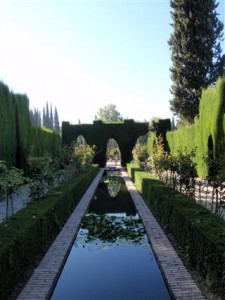
We continued walking towards Alcazaba and through the architectural ruins of the old Muslim city that surrounded and provided support to the fort/castle complex. You can’t wander down into the ruins themselves, but you do get a bird’s eye view and can only imagine what it would have been like in its glory days. Alcazaba is the fortified part of the complex and you can walk along the ramparts and up to the Torre de la Vela for a view of the city below.
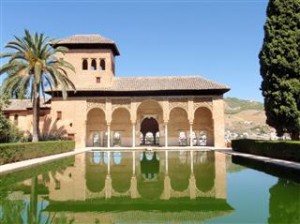
Finally we ventured into the Palacio de Carlos V which I am sure would be impressive in different surroundings. It is a large square building (1527) but inside it is a circular two tiered courtyard and I just couldn’t really see the point of the location of the structure except now it houses a museum.
We then queued up at the entrance to the Palacio Nazaries and were ushered in along with the hundreds of other people who were also in our time slot. So far we hadn’t been that impressed with the complex feeling it was lacking the wow factor that you get from the buildings in India. Stepping inside the palace though takes your breath away and the Islamic architecture is beautiful with the carvings, tiles and geometric patterns overwhelming your senses. The problem for us was that the main courtyard was undergoing renovations with the main water feature and lions being removed, so we were disappointed as nothing was mentioned anywhere about this. Still the remaining of the buildings were beautiful with plenty to see.
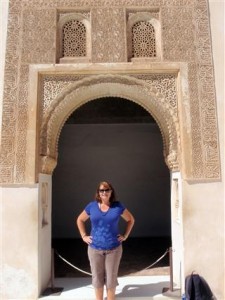
We finally headed out of Alhambra and onto the no. 13 bus into the town, except it dropped us in a different spot, so we asked around found where we had to catch the 175-177 back to the campsite and headed off for a drink and a snack before getting the bus back. Exhausted but happy to go for a swim.
Tuesday, 13 September 2011: Granada
We decided to stay an extra day and head into Granada itself. I am sure a lot of people just come for Alhambra and don’t venture into the sights of Granada. We caught the bus back into the town and headed off to the cathedral where Isabel and Fernando are interred. The city of Granada is very old and has survived a lot of rebuilding and manages to keep its old charm with lots of streets and laneways that allow you to wander with minimal traffic. Downside there are lots of little cobble streets that go up and up and up. We walked up to the Albaycin district to get some photos of Alhambra from across the valley.
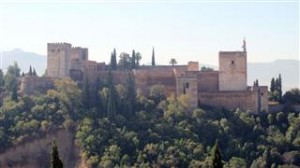
This is a beautiful part of town with lots of morocco themed shops, cafes, restaurants. Scott stopped off and bought a hookah as he was particularly taken with this form of relaxation in Turkey. We spent most of the day wandering through the town stopping to have lunch with the obligatory glass of vino before heading back to the campsite and a final swim.